Location:
PMKI > Project
Management History > The History of Project
Controls.


- The History of Scheduling
- The
History of Bar Charts
- The Origins of WBS
- The History of Cost Controls
- The History of Earned Value Management
- EVM Reference Documents
- Developments in the Creation
and Use of Controls Information
Other related sections of the PMKI:
- Project controls and
scheduling; current practice
- The origins of CPM, PDM and
PERT schedules
- Henry L Gantt (and why bar
charts are not 'Gantt Charts')

The science of ‘scheduling’ as defined by Critical Path Analysis (CPA) has its origins in 1956/57 when Kelly and Walker started developing the algorithms that became the ‘Activity-on-Arrow’ or ADM approach to CPM for DuPont. The program they developed was trialed on plant shutdowns in 1957 and the first paper on critical path scheduling was published in 1958. The PERT system also used the ADM notation, and was developed at around the same time but lagged CPM by 6 to 12 months (although the term ‘critical path’ was invented by the PERT team). Later the Precedence (PDM) methodology was published by Dr. John Fondahl in 1961 as a ‘non-computer’ alternative to CPM. Arguably, the evolution of modern project management is a direct consequence of the need to make effective use of the data generated by the schedulers in an attempt to manage and control the critical path [see: The Origins of Modern Project Management].
The evolution of scheduling closely tracked the development of computers. The initial systems were complex mainframe behemoths, typically taking a new scheduler many months to learn to use. These systems migrated to the ‘mini computers’ of the 1970s and 80s but remained expensive thereby encouraging the widespread use of manual scheduling techniques, with only the larger (or more sophisticated) organizations being able to afford a central scheduling office and the supporting computer systems. The advent of the ‘micro computer’ (ie, personal computer, or PC) changed scheduling for ever. Some of the first commercial software for this class of computer was developed by Micro Planning Services in the UK running on an Apple II. Micro Planner v1.0 was released in 1980 after 14 months development [see more on the history of Micro Planner].
The first IBM PC was launched in 1981; although the definitive IBM XT was not launched until 1983. ‘Windows’ type operating systems became available in 1984 (Apple Macintosh) with ‘Windows v1.0’ (Microsoft) launched in November ‘85. The rapid spread of relatively cheap, easy-to-use PCs spawned dozens (if not hundreds) of PC based scheduling systems including TimeLine, CA Superproject and Primavera. Most of the dominant scheduling software tools available today emanate from this period. By way of example, Primavera was founded in May 1983, the original software being converted from a mainframe batch entry system. Today Primavera is arguably the dominant ‘high end’ project scheduling tool world wide. The evolution of PC based scheduling moved project controls from an environment where a skilled cadre of schedulers operating expensive systems made sure the schedule was ‘right’ (and the organization ‘owned’ the data) to a situation where anyone could learn to drive a scheduling software package, schedules became ‘islands of data’ sitting on peoples’ desktops and the overall quality of scheduling plummeted. Current trends back to ‘Enterprise’ systems supported by PMOs seem to be redressing the balance and offering the best of both worlds. From the technology perspective, information is managed centrally, but is easily available on anyone’s desktop via web enabled and networked systems. From the skills perspective PMOs are re-developing career paths for schedulers and supporting the development of scheduling standards within organizations.
This section provides a holistic overview of the origins of dynamic scheduling and schedule management, and the early development of bar charts. The development of the three types of network diagram CPM, PDM and PERT Schedules are covered in their own sections:
PP: The Origins of Schedule Management. The concepts used for project schedule management have very deep roots. This paper traces the development of the concepts most project managers take for granted including bar charts and critical path schedules from their origins (which are far earlier than most people think) through to the modern day.
PP: A Brief History of Scheduling. This paper tracks the development of scheduling from the emergence of 'bar charts' at the end of the 18th Century through to present times and looks at the way the evolving technology has changed the way projects are scheduled and managed.
Art: A Brief History of Scheduling (short summary).
Prs: Seeing the Road Ahead - the challenge of communicating schedule data. The first part of this presentation outlines the evolution of the graphical presentation of time related data. It briefly reviews the history of visualizing time from 1765 through to 1957 and then focus on the challenges of presenting computer generated schedule data in a meaningful way starting with the hand drawn ADM networks created by Kelley and Walker in 1957. Diversions into mechanical forms of presentation such as Planalog, manual network diagramming and attempts to generate time scaled networks will be outlined through to modern tools such as NetPoint where the focus on presentation is at least as high as the focus on the underlying data. For a longer term view of the evolution of project controls see: Developments in the Creation and Use of Controls Information
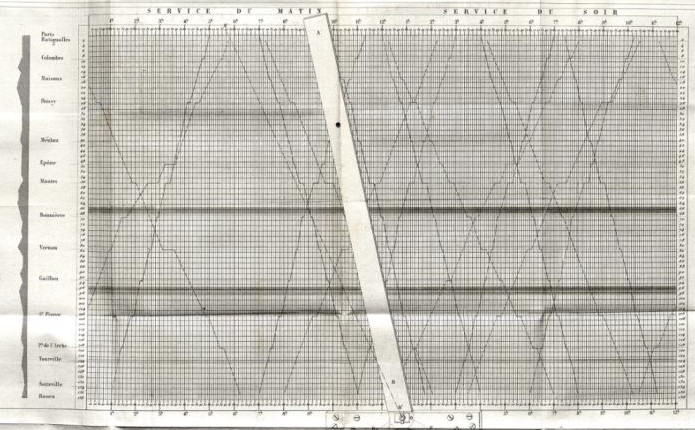 WP:
Line of Balance (LoB). This White Paper
describes the development and use of LoB scheduling and
similar techniques including Flowline and Time/Location
charts, from their origins in the 1840s to visualize train
movements, through to the current time.
WP:
Line of Balance (LoB). This White Paper
describes the development and use of LoB scheduling and
similar techniques including Flowline and Time/Location
charts, from their origins in the 1840s to visualize train
movements, through to the current time.
Art: The origins of PERT and CPM. ‘What came before the computers’. This article looks the origins during and after WW2 of the mathematics and activity-on-arrow (ADM) drawing styles used in both PERT and critical path (CPM) schedules.
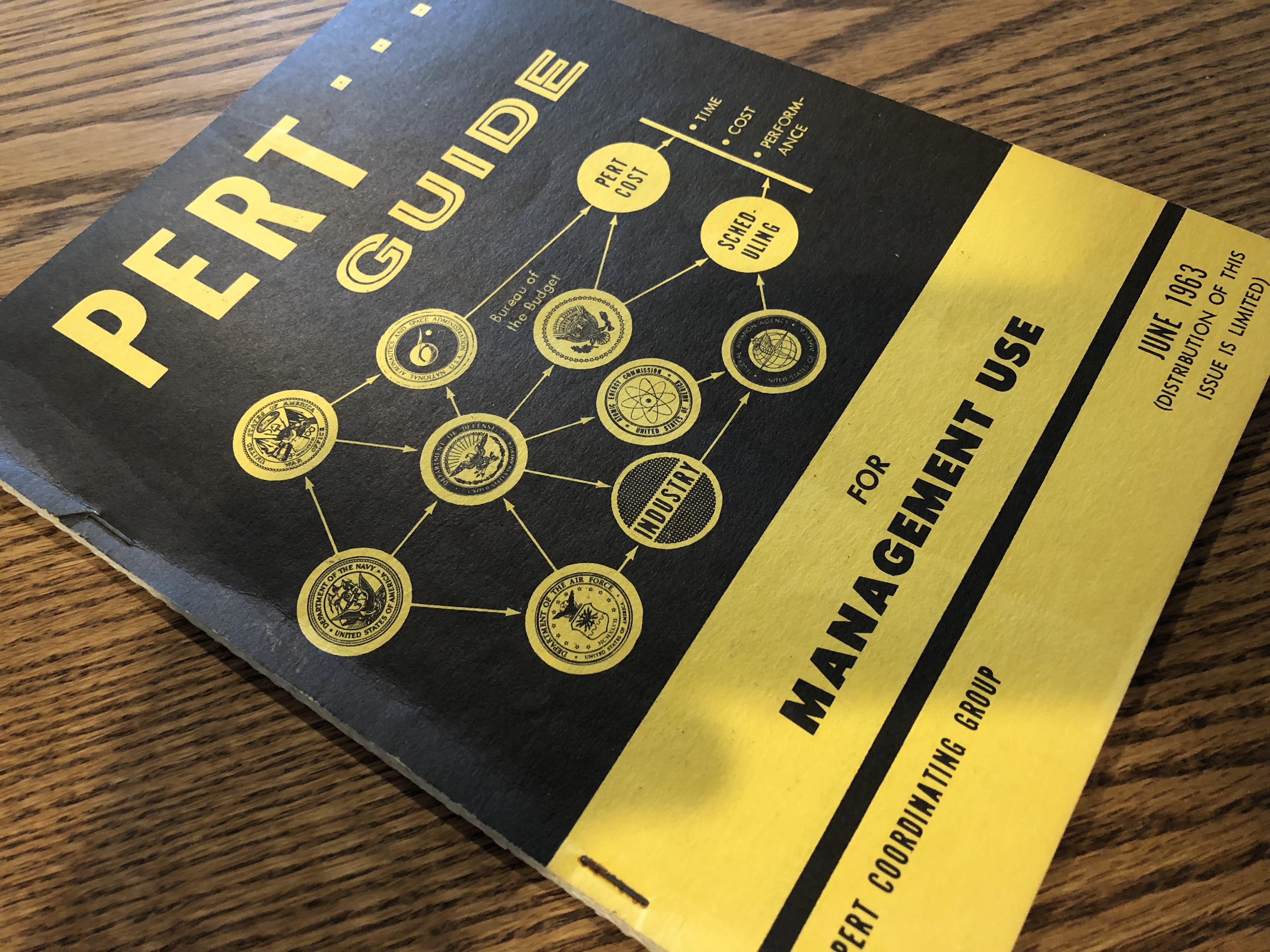
Art:
The Origins of Hammocks and Ladders. Hammock
and Ladders are activity types that were developed in the
period 1961 to 1965. This paper outlines the development
of these useful scheduling assets an differentiates
Hammocks from LOE and Summary activities.
See also extracts from the ICL 1900 PERT manual Circa. 1968.
For more on the history of ICL see our blog: ICL 1900-PERT-50th-anniversary/
The story of Micro Planner - one of the first scheduling tools developed for personal (micro) computers: see the timeline.
What scheduling looked like in 1979 - The development of Micronet for the Apple PC. An analysis only required 6 hours..... See: https://www.praxisframework.org/en/resource-pages/dooley-what-scheduling-looked-like-in-79
Information on applying critical path scheduling to modern projects has been consolidated into an easy-to-read book Easy CPM.
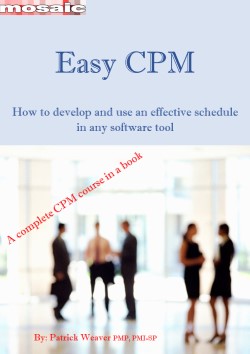 Easy CPM is
a course-in-a-book that provides practical training and
guidance to individuals and organizations involved in
developing or using CPM schedules based on the Critical
Path Method (CPM). It is designed to act as both a
reference, and practice guide, for people implementing CPM
scheduling after they have learned to use the CPM
scheduling software of their choice.
Easy CPM is
a course-in-a-book that provides practical training and
guidance to individuals and organizations involved in
developing or using CPM schedules based on the Critical
Path Method (CPM). It is designed to act as both a
reference, and practice guide, for people implementing CPM
scheduling after they have learned to use the CPM
scheduling software of their choice.
See more, free preview and buy ($35, immediate download).
Click through to our page focused on scheduling.
This subsection augments the history
of scheduling detailed above to focus on
the invention and early use of bar charts (sometimes
incorrectly called 'Gantt Charts). Henry Gantt used bar
charts in his work to improve factory management in the
USA but by the time of his work in the early 20th century
bar charts and and the various other charts developed by
William Playfair (1759-1823) in his ‘Commercial and
Political Atlas’ of 1786 were in common use
world-wide.
Note: Henry Gantt's
contributions to management are significant in the areas
of motivation, workforce management, cost accounting,
and other aspects of Scientific Management. Click
through to see more.
PP: The Origins of Bar Charting. This paper looks at the ancient Greek and Egyptian origins of the concepts used by both Priestly and Playfair as a starting point to develop their charts which in turn led to the development of the modern bar chart by the late 1800s.
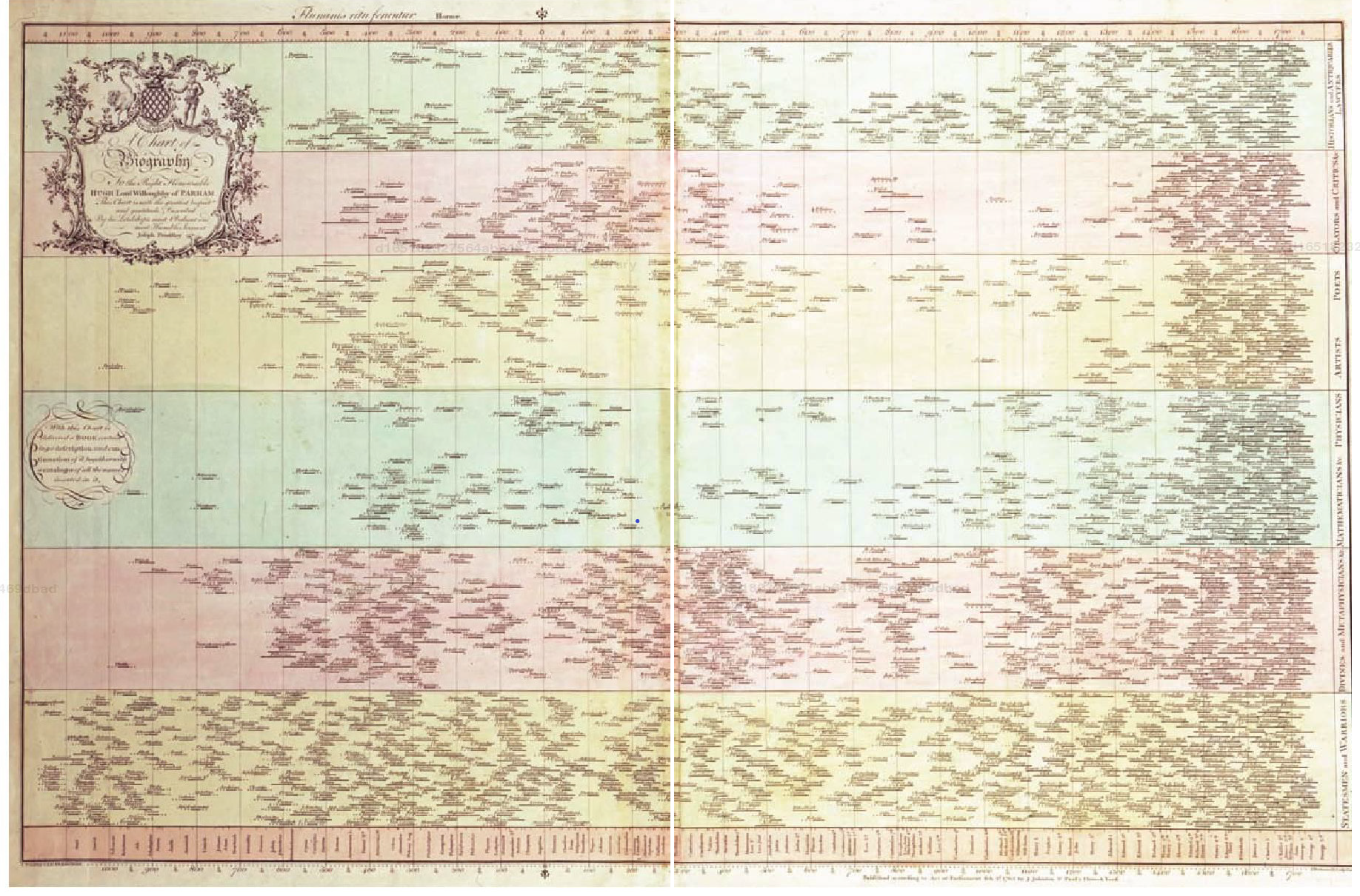 Blg: Bar Charts invented by Joseph
Priestley 1756
Blg: Bar Charts invented by Joseph
Priestley 1756
In the papers looking at the history of project controls
(above), we have asserted the concept of a time scaled bar
chart was the invention of Joseph Priestley in 1756. The
information in this post tends to confirm this view, the
concept was either developed by Priestly, or possibly some
unidentified person prior to 1756, some 200 years before
the work of Henry Gantt was published (see
more on the work of Henry Gantt).
This view is supported by both academic study, and contemporaneous documents:
The 1912 Schürch barchart referenced in the History of Scheduling paper. These are fully developed, sophisticated set of project control tools including a barchart and resource histograms in use many years before Henry Gantt's works were published. Download:
Blg: Henry Gantt vs Karol Adamiecki
Two adaptations of the simple bar chart were the
Harmonogram, (or Harmonygraph / Harmonograf) developed by
Karol Adamiecki in 1896 and the various Gantt Charts
developed by Henry L. Gantt from the early 1900s through
to 1919. This post looks at both the charts, and the
management philosophy of Adamiecki and Gantt and suggests
one possible connection between the work of the two
management pioneers.
PP: The Origins of
WBS & Management Charts.
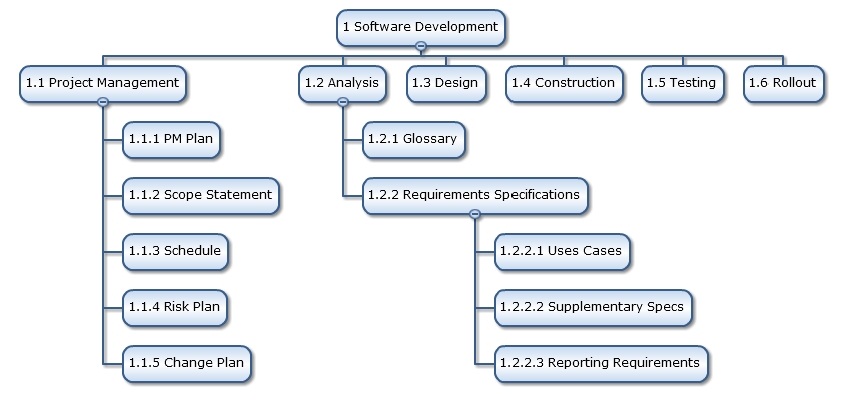 The purpose of this paper is to consolidate the available
information on the creation and evolution of the work
breakdown structure (WBS), and three business charts that
may have led to the creation of the WBS.
The purpose of this paper is to consolidate the available
information on the creation and evolution of the work
breakdown structure (WBS), and three business charts that
may have led to the creation of the WBS.
It is generally accepted the concept of the WBS was not developed until 1957, and the WBS is predated by Organization Charts (1854), Cost Breakdown Structures (1909), and Flow Charts (1921) - see below for links to resources and full size diagrams.
While the roots of a WBS chart may well be found in the
various forms of chart outlined below, the development of
the WBS concept appears to have occurred as part of the
Program Evaluation and Review Technique (PERT). While the
term "work breakdown structure" was not used in by the
PERT team, the first implementation of PERT did organize
its tasks into product-oriented categories
(see more on the
development of PERT).
In June 1962, DoD and NASA published a document describing the PERT/COST system which defined the structure and use of the WBS, nothing much has changed since:
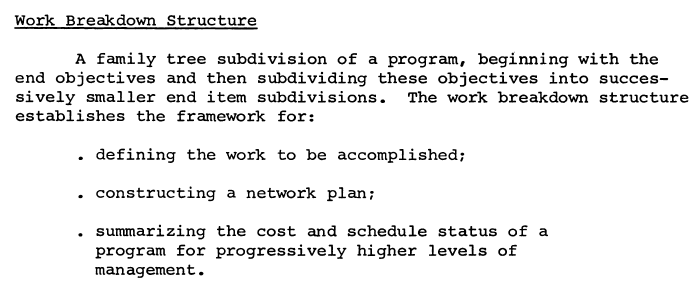
For more on PERT/COST see the History of Earned Value below.
The concept of the WBS was standardized by the publication of MIL-STD-881 on 1 November 1968 by the USA Dept. of Defense. This was followed by MIL-STD-881A on 25 April 1975; this standard has been progressively updated since. Download a copy of MIL-STD-881A.
The first Australian standard for WBS was DEF(AUST) 5664, August 1995: Work Breakdown Structures (WBS) for Defence Materiel projects.
Click through to see more on project breakdown structures in the contemporary section of the PMKI.
The Scottish-American engineer Daniel McCallum (1815–1878) is credited for creating the first organizational charts of American business around 1854. While McCallum’s diagram is rather artistic, more WBS like charts were developed early in the 20th century (although not widely used).
Click on either chart to download a larger version.
Source Wikipedia.
Footnote: The Tabulating Machine Co. (above) was
one of the companies that merged to become IBM.
Click
to open a brief timeline provided by Dr. Mihail Sadeanu.
The continuing usefulness of org-charts in the 21st
century, given the shift towards 'flat' organization
structures, agility, and self management is considered in
Are organization charts still useful?
One of the earliest diagrams of a breakdown structure I've been able to find is from a 1909 book Construction Cost Keeping and Management.

The use of charts to display complex financial and other data was well understood by the start of the 20th century. Charting was an important part of the work of Henry Gantt (see more), and How to make & use graphic charts by Allan C. Haskell was published in 1919.
A few years later, Process Charts were developed and publicized by Frank and Lillian Gilbreth in their 1921 presentation to The American Society of Mechanical Engineers. Process Charts morphed into Flow Charts relatively quickly and were considered normal business diagrams well before the concept of a ‘flow chart’ was used to underpin the PDM network notation developed by Dr. John W Fondahl in 1962 [see more on the development of PDM schedule networks].
The functions of cost estimating, cost control and accounting extend back into antiquity. We know that explaining project cost and time overruns has been a problem at least since Sextus Frontinus had to explain the cost overruns of aqueduct construction to the Roman Emperor Nerva in the 1st Century CE, and probably much earlier. However the discipline of cost engineering appear to be much later development starting in the 19th century, followed by earned value management in the 20th century.
PP: The Origins and History of Cost Engineering. Cost Engineering, the application of cost estimating, cost management, and engineering economics to capital asset management, has a long history. This paper will chart the evolution of cost control from its beginnings as an accounting function, through its use as a performance motivator through to the emergence of Cost Engineering as a distinct discipline in the first half of the 20th Century. It reviews notable developments and leaders in these fields prior to 1960.
References used:
- Treatise on Canals and Reservoirs,
by J. A. Sutcliffe, published by Law and Whittaker,
London, 1816.
- The Iron Age What is an Engineer-Constructor? Article by George A. Damon (USA 1906).
- Cost Keeping and Management
Engineering: A Treatise for Engineers, Contractors and
Superintendents
Engaged in the Management of
Engineering Construction, by Halbert P. Gillette
& Richard T. Dana.
(USA 1909).
- A Manual of Planning & Progress
for Construction Operations: United States War
Department.
Construction Division of the Army,
by Earle B. Morden (USA 1920).
- Manual of Financial and Accounting Procedures for Public Bodies (USA, 1934).
- The
Wheeler Project, Comprehensive Report on the Planning,
Design , Construction, and Initial Operations
of
the Wheeler Project. Tennessee Valley Authority,
USA 1940.
- The Early History of Cost Engineering by John K. Hollmann.
- ENGINEERING ECONOMY - A Historical
Perspective. Gerald J. Thuesen, William G.
Sullivan.
Art: Incentive Payment Schemes. The first linking of payment and performance extends back 100s of years. The payment of 'piece rates' to stone masons, weavers, and other artisans being a set price paid for each 'piece of work' produced. The phrase 'piece work' first appears in writing around the year 1549, but the practice may be older. For example, the 1306 contract between Richard of Stow, mason, and the Dean and Chapter of Lincoln Cathedral, specified that the plain walling would be paid for by measure, and indeed banker marks (identifying who cut the stone) are found on the blocks of walling in this cathedral.
PP: Cost Overruns on
Early Canal & Railway Projects.  The
difficulties in determining a realistic cost for a new
class of project are understandable. But, transport
projects in the United Kingdom (UK) predate the industrial
revolution by several centuries. This suggests that in
addition to the lack of empirical cost information, the
problem with the cost estimates identified in The Origins and History of Cost
Engineering may have been caused by
various combinations of poor governance, questionable
ethics, and optimism bias. The same set of issues that
continue to plague many modern megaprojects.
The
difficulties in determining a realistic cost for a new
class of project are understandable. But, transport
projects in the United Kingdom (UK) predate the industrial
revolution by several centuries. This suggests that in
addition to the lack of empirical cost information, the
problem with the cost estimates identified in The Origins and History of Cost
Engineering may have been caused by
various combinations of poor governance, questionable
ethics, and optimism bias. The same set of issues that
continue to plague many modern megaprojects.
PP: The First Railway Projects. Transport projects in the United Kingdom predate the industrial revolution by several centuries. This paper will look at the building of some of the earliest railway projects (horse drawn wagonways) to identify where possible the contractual and management processes used in their construction and their influence on the industrial revolution.
PP: The First Canal Projects Until the introduction of efficient steam-powered railways, canals were the driving force behind the industrial revolution. This paper looks at the development of canals in the UK from Roman times through to the start of the 'canal mania' in the 1790s, and seek to identify where possible the contractual and management processes used in their construction.
Blg:
Transport project cost overruns are not new!
The questionable ethics around the funding of some canal
development in England 1760 and 1830 are highlighted.
This post is based on Treatise on Canals and
Reservoirs, by J. A. Sutcliffe, published by
Law and Whittaker, London, 1816. Download the book.
Note: Governance mechanisms for companies companies were first legislated several years after the Treatise was published; see more on the history of governance.
Click through to our page on project
cost controls.
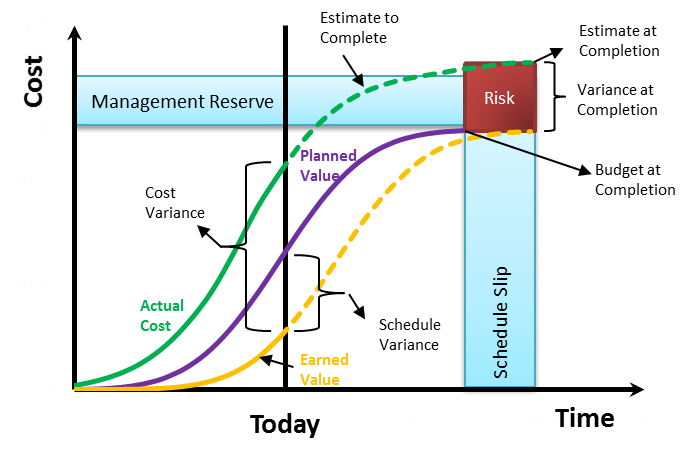 The
fundamental difference between cost engineering discussed
above and earned value management is the way information
is used. Both approaches estimate the expected future cost
of the works and both collect and compare actual costs
with both the estimated value of the work accomplished,
and assess the difference between the work actually done,
and the work planned to have been done as at a point in
time. The difference is cost engineering identifies
problems for management to resolve, it is passive and
reactive; based on financial accounting information. Where
as Earned Value incorporates a structured forecasting
process.
The
fundamental difference between cost engineering discussed
above and earned value management is the way information
is used. Both approaches estimate the expected future cost
of the works and both collect and compare actual costs
with both the estimated value of the work accomplished,
and assess the difference between the work actually done,
and the work planned to have been done as at a point in
time. The difference is cost engineering identifies
problems for management to resolve, it is passive and
reactive; based on financial accounting information. Where
as Earned Value incorporates a structured forecasting
process.
Earned Value Management has three fundamental components:
The concept of EVM did not suddenly appear, its
foundations were laid by previous generations. EVM is a
synthesis of ideas and concepts some of which are hundreds
of years old.
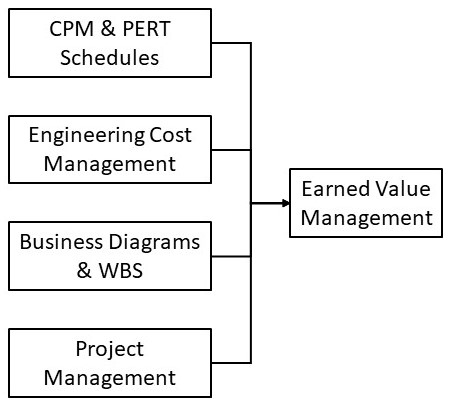 The
four precursors to EVM are:
The
four precursors to EVM are:
PP:
The Origins and History of Earned Value Management.
The purpose of this paper is to outline the development of
Earned Value and Earned Schedule. The concept of project
controls has a long history of continuous development and
innovation, however, the use of deterministic information
to predict future outcomes only appears to have started
started in the late 1950s with PERT and CPM, and
progressed through PERT-COST to the point where there is
general acceptance that Earned Value Management and Earned
Schedule are the best of the predictive control tools.
Many of the referenced documents are
available for downloading.
Blg: The Origins + History of Earned Value Management. This post covers the inputs to the creation of EVM as described in The Origins and History of Earned Value Management.
Prs: The Origins of EVM. A PowerPoint overview of the development of EVM from the 1950s to 2021 extracted from the main paper during development.
PP: Earned Schedule - the First 20 Years. The concept of Earned Schedule (ES) was introduced to the EVM community In 2003, by the publication by Walt Lipke of Schedule is Different. Earned Schedule resolved the long-standing dilemma of the EVM schedule indicators providing false information for late performing projects, provides the ability to predict project completion dates with more accuracy then CPM, and is the bridge for performing meaningful schedule analysis from the EVM data. It uses the same data as traditional EVM, but shifts the calculations from the cost axis to the time axis. This paper traces the development of ES during the first 20 years.
PP: Earned Value Management – Early Computers. The use of mainframe computers in the 1960s was integral to the development of Earned Value Management. This paper looks at some of the earliest developments.
Prs: Earned Value Management – Past, Present & Future. An overview of the development of EVM, the current state of development, and some thoughts about using EVM in a future integrated design and controls system.
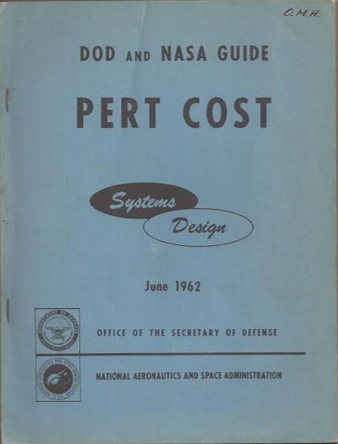 DP:
USAF PERT COST System Description Manual.
This is Volume III of the USAF PERT series, as at March
1963. It contains a detailed description of the USAF PERT
Cost System. It provides methodology and guidance and
serves as a reference for all levels of management in the
application of PERT Cost.
DP:
USAF PERT COST System Description Manual.
This is Volume III of the USAF PERT series, as at March
1963. It contains a detailed description of the USAF PERT
Cost System. It provides methodology and guidance and
serves as a reference for all levels of management in the
application of PERT Cost.
DP: DOD NASA PERT COST Output Reports. Supplement No.1 to DOD and NASA Guide, PERT COST Output Reports, March 1963. Defines the standard reporting formats to be used by a PERT COST system.
DP: The 1964 Evaluation of PERT/Cost. This original paper looks at the challenges of assessing the business value of using the PERT/Cost system following its introduction in 1963/64. The report findings are still relevant!
ANSI/EIA-748:1998 Earned Value Management Systems. The first of the 748 series of standards
Click through to see more on PERT/Time
Key papers and articles referenced in The Origins and History of EVM:
- ANSI/EIA-748:1998 Earned Value Management Systems.
- AS 4817:2003 Project performance measurement using Earned Value.
- Cost Data Base Development - A
Twelve-Year Perspective.
Leggitt, A.C., October 1981.
- Cost/Schedule Planning Control
Specification,
Lorette, R.J., Roth, B.J., The Air Force
Comptroller Vol.4 No.1, Jan 1970.
- DEF(AUST) 5655, October 1992: Australian Cost/Schedule Control Systems Criteria.
- DEF(AUST) 5657, March 1994: Australian
Cost/Schedule Control Systems Criteria
Implementation Guide.
- DEF(AUST) 5658, February 1994:
Cost/Schedule Status Reporting (CSSR) Specification
and
Implementation Guide.
- DOD's
5000 Documents: Evolution and change in defense
acquisition policy.
Ferrara, J., Acquisition Review Quarterly—Fall
1996.
- DODI
7000.2, June 10 1977: Performance Measurement for
Selected Acquisitions.
Including Cost/Schedule Control Systems
Criteria at Encl. 1.
- DODI
7000.10 December 3, 1979:
Contract
Cost Performance, Funds Status and Cost/Schedule Status
Reports.
- Earned
Value Management — Reconciling Government and
Commercial Practices.
Abba,
W.F., PM: Special Issue January - February 1997.
- How It All Began: The Creation Of
Earned Value And The Evolution Of C/SPCS And C/SCSC.
Measurable News 2016-01. Morin, B.J.
- PARCA - EVM Application & the
updated DoDI 5000.02 2017.
See also DoD Earned Value Implementation Guide.
- Performance Management Association - President's Report / History, 22 March 1987.
- Performance Measurement Systems, Recent
Systems Development and Applications.
Rigney, R.A. 1979.
- PERT Time/Cost; An Aid to Agribusiness Management. Ken D. Duft.
- Progress Report on Martin's Titan III Incentives (January 1963 to March 1966), Chapman, R.W.
- Schedule is Different. The seminal paper introducing Earned Schedule, Lipke, W., 2003.
- USAF Oral History, interview with
Lieutenant General Hans H. Driessnack (1987).
His involvement in PERT/COST, C-Spec and
C/SCSC start at page 105 of the full interview.
The two controls capabilities needed for effective project management in the current era are a good schedule supporting a sensible earned value management system (EVMS). The information needed to apply these concepts to modern projects has been consolidated into two easy-to-read books Easy EVM and Easy CPM:
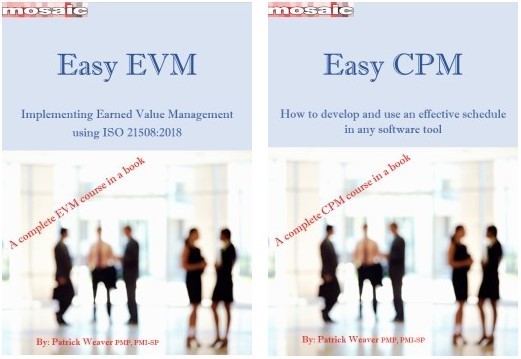 Both are designed as a course-in-a-book to provide
practical training and guidance to individuals and
organizations involved in developing or using, either
earned value management, or CPM schedules based on the
Critical Path Method (CPM).
Both are designed as a course-in-a-book to provide
practical training and guidance to individuals and
organizations involved in developing or using, either
earned value management, or CPM schedules based on the
Critical Path Method (CPM).
Easy CPM is designed to act as a reference
and practice guide for people implementing CPM scheduling
after they have learned to use the CPM scheduling software
of their choice.
See more, free preview and buy
$35, immediate download).
Visit our EVM resources and training page.
Prs: Seeing the Road Ahead - the challenge of communicating schedule data. This presentation looks at the challenges faced by project controls professionals, both in the past and present times, to communicate sophisticated information to other members of the project team and their stakeholders and some of the tools and processes they used.
Blg: The Phases of Project Controls. This post updates the 2015 blog, three phases pf project controls to map developments from the earliest projects through to the early 2030s.
Blg: The three phases of project controls. The reactive, empirical and predictive phases of project controls (see also Predicting Completion).
Blg: Predicting Completion. When did managers start using data to calculate project completion times and costs? It would appear to be a development of the 1950s.